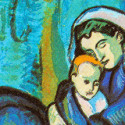The concept of foreground and background is one way artists can consider perception in their works. They work to push and pull different areas or aspects of the work into and out of the foreground and background, placing emphasis on where they feel it belongs and ultimately leading the viewers or listeners eyes and/or ears on an engaging visual or aural tour.

We’re all faced with push and pull in our daily lives, making decisions about what comes forward in any given moment and what falls back as support. We often give in to what feels like the safest choice rather than what feels right in any given situation. To use artistic awareness in our daily lives, it’s necessary to make choices and push and pull things in and out of the foreground and background to shape their significance.
There are times when the choice is difficult, but all of us have the opportunity to express ourselves with integrity every moment of every day just like artists who are deeply connected to expressing themselves without limiting their choices. If artists give in to take the safest route, their expression is never clear, they disconnect from who they are, and their work doesn’t resonate in the same way.
Never, never be afraid to do what’s right…. Society’s punishments are small compared to the wounds we inflict on our soul when we look the other way.
~ Martin Luther King, Jr.
It’s really a matter of arranging the parts and using the artistic techniques to move elements forward or backward to suggest what is of most importance or secondary. This song—Someone Like You performed by Adele—is a simple example of foreground and background in musical performance. The importance is unmistakably placed on Adele, although the piano is certainly there for support.
Imagine what you might experience if the piano was in the foreground and the singer in a supportive role. While it can sometimes become more complex with multiple layers, more often than not the eye and ear can easily follow what is placed as primary importance. Perception is important, and multiple layers can add depth; what is brought to the foreground is certain to influence the outcome.

Some of the techniques used by artists to lead our eyes and ears include—
[sws_checklist]
- Complexity—where there is the most visual or aural activity, there is the perception of greater importance. In our daily lives, it’s the actions we choose in the midst of chaos that come to the fore and matter most in the end.
- Contrasts of color or musical timbre—the fullest and most intense colors and timbres demand our attention. We can choose to live our lives fully and bring out the brightest and richest aspects of who we are as human beings.
- An unusual or new element—something new in the midst of something familiar. Don’t be afraid to bring new things into your life or stand up for what’s right in the middle of turmoil and confusion.
- Form—structure can be used to highlight something and bring it forward. A change of routine can lead to important changes of focus and meaning in our lives.
[/sws_checklist]
Take time to fully express yourself as an artist. Explore the foreground and background of your daily life experiences. Highlight each moment with what is most important and connect them together over time to create your greatest art.
I am seeking. I am striving. I am in it with all my heart.
~ Vincent van Gogh
— Pat
Sign-up for the Arts Awareness eNewsletter and receive a free gift “Three Lessons to Begin to Make Artistic Principles Work for You in Fascinating Ways.” Like Arts Awareness on facebook.
